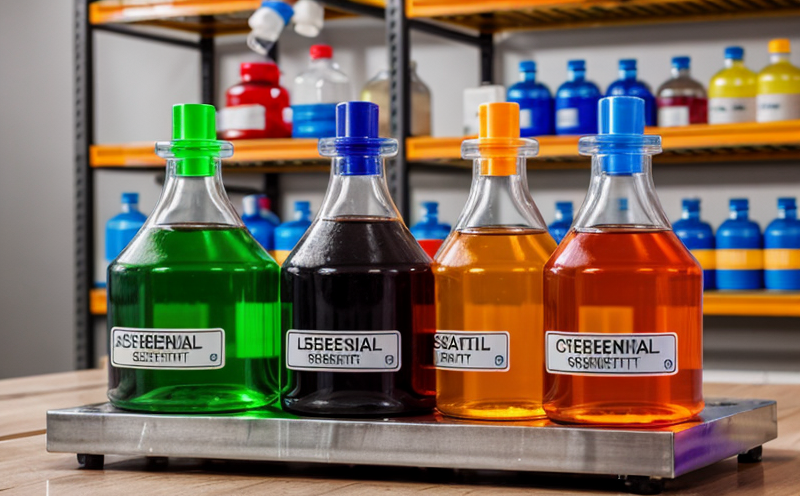Toluene Content Testing in Adhesives and Paints
Understanding toluene content in adhesives and paints is crucial for ensuring compliance with international standards and regulations. Toluene, a volatile organic compound (VOC), poses significant health risks when used or stored improperly. This makes the testing of toluene content essential not only for product safety but also for environmental protection.
The testing process involves several key steps that are designed to ensure accurate and reliable results. Initially, samples from adhesives and paints must be collected in a manner that represents the entire batch accurately. Properly stored specimens can then undergo initial screening using gas chromatography (GC), which separates and identifies individual components present in the sample.
Following this, quantitative analysis is conducted to determine the exact concentration of toluene within the adhesive or paint. This step often involves more advanced techniques such as mass spectrometry coupled with GC (GC-MS) for enhanced precision. The results from these tests are compared against international standards like ISO 17220 and ASTM D4683, which provide reference levels for acceptable toluene content.
The significance of accurate testing cannot be overstated; it ensures that products meet stringent regulatory requirements set forth by bodies such as the European Union's REACH regulation or OSHA in North America. By adhering to these standards, manufacturers can protect their reputations and avoid costly recalls due to non-compliance issues.
In addition to health implications for workers handling these materials directly, there are broader environmental considerations. High levels of VOCs like toluene contribute to smog formation and other air quality problems when released into the atmosphere during application or drying processes. Therefore, accurate measurement helps minimize such adverse effects by informing formulation adjustments aimed at reducing emissions without compromising performance.
It is also important to note that proper testing plays a critical role in R&D efforts focused on developing safer alternatives for consumers and workplaces alike. By continually monitoring changes in chemical composition throughout the development lifecycle, developers can identify potential hazards early on and implement corrective measures accordingly.
Why Choose This Test
The decision to conduct toluene content testing is influenced by various factors including regulatory compliance, product quality assurance, and worker safety. Regulatory compliance ensures that products are safe for both consumers and the environment while also protecting companies from potential legal actions.
From a quality assurance perspective, consistent monitoring helps maintain high standards across production batches, ensuring uniformity in performance characteristics such as adhesion strength or drying time among different containers of paint or tubes of adhesive. This consistency is vital for brand loyalty and customer satisfaction.
Worker safety remains another key reason why thorough testing should be prioritized. Exposure to hazardous chemicals like toluene can lead to various health issues ranging from mild irritation to severe respiratory disorders if proper precautions are not taken during handling operations. Regular assessments allow employers to implement necessary protective measures effectively, thereby safeguarding employee wellbeing.
Moreover, conducting such tests allows manufacturers to stay ahead of changing market trends and consumer expectations regarding eco-friendliness and sustainability. As environmental concerns grow globally, companies that demonstrate proactive approaches towards minimizing their carbon footprint will gain competitive advantages over those lagging behind in terms of innovation and responsibility.
Quality and Reliability Assurance
The importance of quality and reliability assurance cannot be overstated when it comes to ensuring customer satisfaction. In the context of toluene content testing for adhesives and paints, maintaining consistent standards is paramount. This involves not only adhering strictly to predefined thresholds but also implementing robust quality control measures at every stage of manufacturing.
Firstly, rigorous sampling procedures ensure that each batch tested reflects true average properties rather than anomalies present in individual samples. By following standardized practices laid out by organizations such as ASTM or ISO, laboratories can establish credibility and trustworthiness among clients.
Secondly, employing advanced analytical methods like GC-MS guarantees precision and accuracy in quantifying trace amounts of toluene present in complex mixtures commonly found within these products. Such sophisticated equipment allows for more reliable measurements compared to simpler techniques, reducing margin errors significantly.
In addition to technical proficiency, maintaining certifications from reputable accrediting bodies such as ANSI/NSTL further enhances reliability by demonstrating compliance with recognized international standards. These credentials provide assurance that the testing facility meets stringent criteria regarding personnel qualifications, instrument calibration, and laboratory operations.
Finally, transparent reporting practices play a crucial role in building long-term relationships with clients who rely on accurate information about their purchased goods' composition. Providing detailed reports complete with raw data, interpretations, and recommendations fosters trust while offering valuable insights into potential areas for improvement within formulations.
Customer Impact and Satisfaction
The outcomes of thorough toluene content testing directly impact customer satisfaction by addressing safety concerns, enhancing product quality, and meeting regulatory expectations. For consumers, knowing that the products they purchase comply with established health and environmental standards offers peace of mind.
Incorporating this service into your purchasing process ensures that only safe materials are used in final products, thus protecting end-users from exposure to harmful substances during use or disposal phases. This transparency builds trust between suppliers and purchasers, fostering stronger business relationships built on mutual respect and shared goals.
For manufacturers, having reliable data about the composition of raw materials enables informed decisions regarding formulation adjustments aimed at improving both performance attributes and sustainability metrics without sacrificing quality standards. By staying attuned to evolving consumer preferences driven by increased awareness around green initiatives, companies can position themselves favorably in competitive markets.
The commitment to rigorous testing also demonstrates a company's dedication to corporate social responsibility (CSR), contributing positively toward global efforts towards cleaner air and reduced waste production. Such actions resonate well with stakeholders ranging from investors to local communities, enhancing overall brand reputation significantly.





